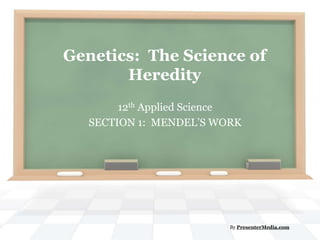
Genetics section 1 notes
- 1. Genetics: The Science of Heredity 12th Applied Science SECTION 1: MENDEL’S WORK By PresenterMedia.com
- 2. Gregor Mendel The first recorded scientific study of how traits pass from one generation to the next was done by Gregor Mendel, a monk! In 1856, he began experimenting with garden peas. I. Introduction to Genetics
- 3. I. Introduction to Genetics He believed he could predict the kinds of flowers and fruits a plant would produce. To do this he believed that something had to be known about the parents of the plants. Each different form of a characteristic, such as a stem height, is called a TRAIT. Today, Mendel’s discoveries form the foundation of Genetics. Father of Genetics
- 4. I. Introduction to Genetics Mendel’s Experiments Fertilization occurs when egg and sperm join. Before this can happen in pea plants, pollen must reach the pistil of the flower. This process is called pollination. Mendel developed a method by which he cross pollinated, or “crossed” pea plants.
- 5. I. Introduction to Genetics Crossing Pea Plants An organism that always produces the same traits in its offspring is called a PUREBRED. Example: PUREBRED short pea plants always come from short parent plants. Tall plants that always produce tall plants are considered PUREBRED tall plants.
- 6. I. Introduction to Genetics Crossing Pea Plants In one experiment, Mendel crossed purebred tall plants with purebred short plants. Scientists call the parent plants the parental generation or the “P generation” The offspring from this cross are the first fillial generation or the “F1 generation”. Fillial comes from the word fillia: the Latin word for daughter All of the offspring from this cross were TALL.
- 7. I. Introduction to Genetics Crossing Pea Plants When the plants in the F1 generation were full grown, Mendel allowed them to self pollinate. Some of the plants in the F2 generation were a mix of tall and short plants. ¾ were tall ¼ were short.
- 8. I. Introduction to Genetics
- 9. Dominant and Recessive Traits Genes are factors that control traits. Genes are made up of DNA Genes are found on chromosomes. I. Introduction to Genetics
- 10. Dominant and Recessive Traits The different forms a gene may have for a trait are its alleles. Each new organism inherits two alleles from its parents. One from the egg (mother) and the other from the sperm (father). A pea plant may inherit two alleles for tall stems, two alleles for short stems, or one of each. I. Introduction to Genetics
- 11. Dominant and Recessive Traits An organisms traits are controlled by the alleles it inherits from its parents. Dominant Allele is one whose trait always shows up in the organism when the allele is present. Recessive Allele is hidden whenever the dominant allele is present. A trait controlled by a recessive allele will only show up if the organism does not have the dominant allele. I. Introduction to Genetics
- 12. Dominant and Recessive Traits in Pea Plants are shown in the table to the right. If the dominant allele is present it will mask the recessive allele. Example: If a pea plant has both purple and white flower alleles the purple allele will be the one that is visible to you. I. Introduction to Genetics
- 13. II. Probability and Heredity Probability Probability is the number that describes how likely it is that an event will occur. Probability is different then the odds. Probability = what you want / total chances Odds= what you want: what you don’t want
- 14. II. Probability and Heredity Punnett Squares A handy tool to use to predict results in Mendelian Genetics is the Punnett Square. A Punnett Square is a chart that shows all the possible combinations of alleles that can result from a genetic cross. Y= Yellow y= Green
- 15. II. Probability and Heredity Punnett Squares Dominant alleles are represented by capital letters. Recessive alleles are represented by lower case letters. An organism that has two identical alleles is called HOMOZYGOUS. An organism that has two different alleles is called HETEROZYGOUS. Y= Yellow y= Green Yy= Heterozygous yy= Homozygous
- 16. II. Probability and Heredity Using a Punnett Square Monohybrid Cross deals with only one trait. Yellow pea plants being crossed with green pea plants. Di-hybrid cross deals with two traits. a. Tall Yellow Pea Plants crossed with Tall Green Pea Plants
- 17. TtYy X TtyyTall Yellow Pea Plants X Tall Green Pea Plants Plant one is Heterozygous Tall; Heterozygous Yellow. Plant Two is Heterozygous tall green pea plants.
- 19. II. Probability and Heredity Phenotype An organisms phenotype is its physical appearance, or its visible traits. Phenotypic Ratio The ratio of phenotypes found in the Punnett Square. Pea plants can have one of two different phenotypes for stem height-Short or Tall. Genotype An organisms genotype is its genetic makeup, or allele combinations. Although all of the tall plants have the same phenotype, they can have two different genotypes-TT or Tt A Genotypic Ratio is the ratio of genotypes found in a Punnett Square.
- 20. Comparing Phenotype and Genotype II. Probability and Heredity
- 21. G. CoDominance H. Incomplete Dominance For some alleles, an inheritance pattern called co-dominance exists. In co-dominance, the alleles are neither dominant nor recessive. As a result, both alleles are expressed in the offspring. When two traits are not completely dominant over each other. This results in a blending of the two traits. Example: RR = Red Flowers WW= White Flowers RW = Pink flowers II. Probability and Heredity
- 22. Please Review the following videos on Blended Schools: Mendelian Genetics- A Quick Tutorial Incomplete and Codominance Review End of Genetics Section I Notes!! Complete the Punnett Square Packet!! II. Probability and Heredity
- 23. Punnett Square Packet Answers